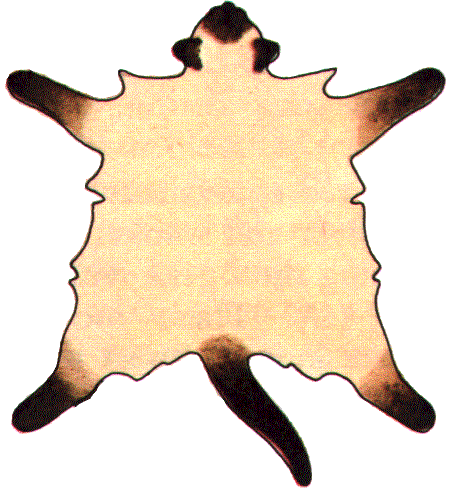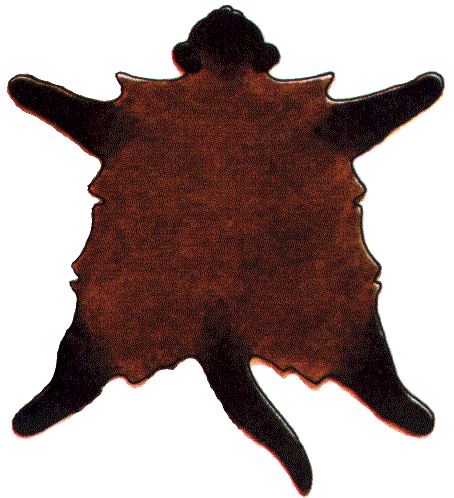| |
female |
| aBcsDotb |
aBcs-otb |
a-csDotb |
a-cs-otb |
| male |
ABcsDOtb |
AaBBcscsDDOotbtb
seal tortie tabbypoint female |
AaBBcscsD-Ootbtb
seal tortie tabbypoint female |
AaB-cscsDDOotbtb
seal tortie tabbypoint female |
AaB-cscsD-Ootbtb
seal tortie tabbypoint female |
| ABcsDYtb |
AaBBcscsDDoYtbtb
seal tabbypoint male |
AaBBcscsD-oYtbtb
seal tabbypoint male |
AaB-cscsDDoYtbtb
seal tabbypoint male |
AaB-cscsD-oYtbtb
seal tabbypoint male |
| ABcs-Otb |
AaBBcscsD-Ootbtb
seal tortie tabbypoint female |
AaBBcscs--Ootbtb
seal/blue tortie tabbypoint female |
AaB-cscsD-Ootbtb
seal tortie tabbypoint female |
AaB-cscs--Ootbtb
seal/blue tortie tabbypoint female |
| ABcs-Ytb |
AaBBcscsD-oYtbtb
seal tabbypoint male |
AaBBcscs--oYtbtb
seal/blue tabbypoint male |
AaB-cscsD-oYtbtb
seal tabbypoint male |
AaB-cscs--oYtbtb
seal/blue tabbypoint male |
| A-csDOtb |
AaB-cscsDDOotbtb
seal tortie tabbypoint female |
AaB-cscsD-Ootbtb
seal tortie tabbypoint female |
Aa--cscsDDOotbtb
seal/chocolate/cinnamon tortie tabbypoint female |
Aa--cscsD-Ootbtb
seal/chocolate/cinnamon tortie tabbypoint female |
| A-csDYtb |
AaB-cscsDDoYtbtb
seal tabbypoint male |
AaB-cscsD-oYtbtb
seal tabbypoint male |
Aa--cscsDDoYtbtb
seal/chocolate/cinnamon tabbypoint male |
Aa--cscsD-oYtbtb
seal/chocolate/cinnamon tabbypoint male |
| A-cs-Otb |
AaB-cscsD-Ootbtb
seal tortie tabbypoint female |
AaB-cscs--Ootbtb
seal/blue tortie tabbypoint female |
Aa--cscsD-Ootbtb
seal/chocolate/cinnamon tortie tabbypoint female |
Aa--cscs--Ootbtb
seal/chocolate/cinnamon tortie tabbypoint
or blue/lilac/fawn tortie tabbypoint female |
| A-cs-Ytb |
AaB-cscsD-oYtbtb
seal tabbypoint male |
AaB-cscs--oYtbtb
seal/blue tabbypoint male |
Aa--cscsD-oYtbtb
seal/chocolate/cinnamon tabbypoint male |
Aa--cscs--oYtbtb
seal/chocolate/cinnamon tabbypoint
or blue/lilac/fawn tabbypoint male |
| aBcsDOtb |
aaBBcscsDDOotbtb
seal tortie point female |
aaBBcscsD-Ootbtb
seal tortie point female |
aaB-cscsDDOotbtb
seal tortie point female |
aaB-cscsD-Ootbtb
seal tortie point female |
| aBcsDYtb |
aaBBcscsDDoYtbtb
seal point male |
aaBBcscsD-oYtbtb
seal point male |
aaB-cscsDDoYtbtb
seal point male |
aaB-cscsD-oYtbtb
seal point male |
| aBcs-Otb |
aaBBcscsD-Ootbtb
seal tortie point female |
aaBBcscs--Ootbtb
seal/blue tortie point female |
aaB-cscsD-Ootbtb
seal tortie point female |
aaB-cscs--Ootbtb
seal/blue tortie point female |
| aBcs-Ytb |
aaBBcscsD-oYtbtb
seal point male |
aaBBcscs--oYtbtb
seal/blue point male |
aaB-cscsD-oYtbtb
seal point male |
aaB-cscs--oYtbtb
seal/blue point male |
| a-csDOtb |
aaB-cscsDDOotbtb
seal tortie point female |
aaB-cscsD-Ootbtb
seal tortie point female |
aa--cscsDDOotbtb
seal/chocolate/cinnamon tortie point female |
aa--cscsD-Ootbtb
seal/chocolate/cinnamon tortie point female |
| a-csDYtb |
aaB-cscsDDoYtbtb
seal point male |
aaB-cscsD-oYtbtb
seal point male |
aa--cscsDDoYtbtb
seal/chocolate/cinnamon point male |
aa--cscsD-oYtbtb
seal/chocolate/cinnamon point male |
| a-cs-Otb |
aaB-cscsD-Ootbtb
seal tortie point female |
aaB-cscs--Ootbtb
seal/blue tortie point female |
aa--cscsD-Ootbtb
seal/chocolate/cinnamon tortie point female |
aa--cscs--Ootbtb
seal/chocolate/cinnamon tortie point
or blue/lilac/fawn tortie point female |
| a-cs-Ytb |
aaB-cscsD-oYtbtb
seal point male |
aaB-cscs--oYtbtb
seal/blue point male |
aa--cscsD-oYtbtb
seal/chocolate/cinnamon point male |
aa--cscs--oYtbtb
seal/chocolate/cinnamon point
or blue/lilac/fawn point male |

